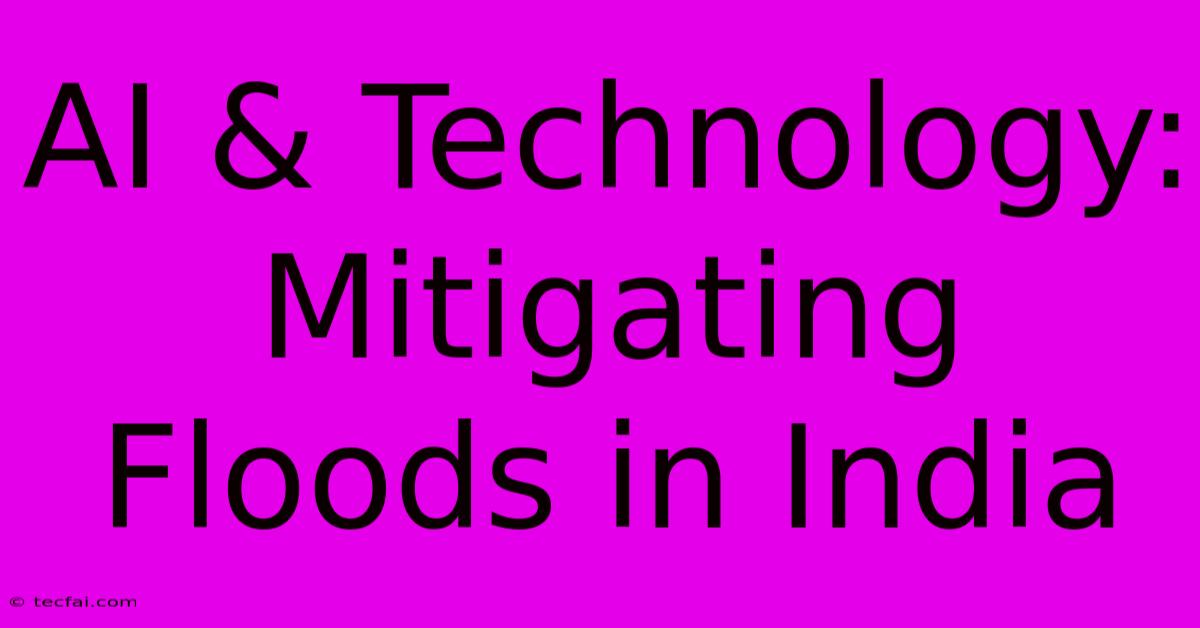AI & Technology: Mitigating Floods In India

Discover more detailed and exciting information on our website. Click the link below to start your adventure: Visit Best Website tecfai.com. Don't miss out!
Table of Contents
AI & Technology: Mitigating Floods in India
India, a land of diverse landscapes and rich heritage, is also highly vulnerable to natural disasters, particularly floods. The monsoon season, while crucial for agriculture, often brings devastating floods, causing widespread damage to infrastructure, property, and lives. In recent years, the frequency and intensity of these floods have increased due to climate change, making flood mitigation an urgent priority. This is where AI and technology are stepping in to play a crucial role in mitigating the impact of floods in India.
AI-Powered Flood Prediction and Early Warning Systems
Artificial Intelligence (AI) is proving to be a game-changer in flood prediction and early warning systems. By analyzing vast datasets of historical flood data, weather patterns, rainfall forecasts, and real-time sensor data, AI algorithms can identify patterns and predict flood events with greater accuracy and lead time.
Here's how AI is contributing:
- Predictive Modeling: AI models can analyze meteorological data and predict flood risk levels for specific regions, helping authorities issue timely alerts and initiate preparedness measures.
- Real-Time Monitoring: AI-powered systems can monitor water levels in rivers and reservoirs using sensors and satellite imagery, providing real-time updates on potential flood situations.
- Smart Infrastructure: Integrating AI with flood monitoring systems helps in optimizing water management infrastructure, such as dams and levees, for better flood control.
Leveraging Technology for Flood Mitigation
Technology plays a vital role in the entire flood mitigation process, not just prediction.
Here's how technology is being used:
- Remote Sensing: Satellite imagery and aerial drones can provide detailed insights into flood-affected areas, helping in damage assessment and relief efforts.
- Communication Systems: Mobile apps and social media platforms are used to disseminate flood warnings and alerts, enabling quicker and wider reach to vulnerable communities.
- Digital Maps and Navigation: Interactive maps and navigation tools help people navigate flood-affected areas, identify safe routes, and locate shelters.
- Drone Technology: Drones are deployed for aerial surveillance, search and rescue operations, and delivering essential supplies to inaccessible areas.
The Future of Flood Mitigation in India
The integration of AI and technology in flood mitigation is still evolving, but its potential is immense.
Here are some future directions:
- Advanced AI models: Developing more sophisticated AI models capable of simulating flood events with higher accuracy and incorporating real-time factors.
- Integration with existing infrastructure: Integrating AI and technology seamlessly with existing flood control infrastructure, such as dams, levees, and drainage systems.
- Community Engagement: Developing user-friendly mobile apps and platforms to engage communities in flood preparedness and awareness initiatives.
By harnessing the power of AI and technology, India can significantly reduce the impact of floods and build a more resilient future for its citizens. This requires a coordinated effort from government agencies, research institutions, private companies, and communities to embrace these innovations and implement them effectively.

Thank you for visiting our website wich cover about AI & Technology: Mitigating Floods In India . We hope the information provided has been useful to you. Feel free to contact us if you have any questions or need further assistance. See you next time and dont miss to bookmark.
Featured Posts
-
Stein On Election Democrats To Blame
Nov 06, 2024
-
Fox News Wins Big In Us Election
Nov 06, 2024
-
Aps Method For Calling Elections
Nov 06, 2024
-
Bitcoin Hits 75 000 Trump Win Fuels Rally
Nov 06, 2024
-
Senate Power Shift Republicans Take Majority
Nov 06, 2024
